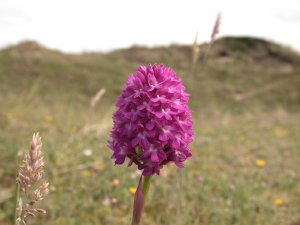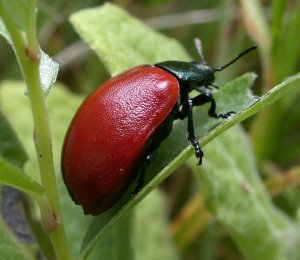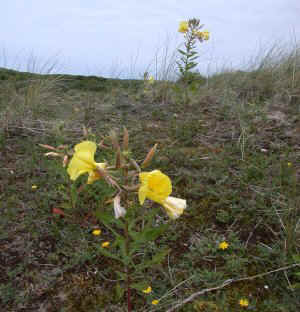Braunton Burrows is a magical place to visit in early
July when the majority of the turf plants are flowering.
.
 |
Low carpets of aromatic
purple Thyme mingle with pink-flowered Restharrow, the delicate lemon yellow of Mouse-ear
Hawkweed, striking blue spikes of Viper's Bugloss and amazing numbers of Pyramidal Orchids
(left). |
| Hard sun-baked
lichens, which form an important part of the turf community, crunch underfoot, while
mosses are also an important component..The dune slacks host
herbs such as Meadowsweet, Bog Pimpernel, Marsh Fritillary and Southern Marsh Orchids,
along with bushes of Creeping Willow and Privet. |
 |
The Creeping Willow is home
to large numbers of brilliant red Poplar Leaf Beetles (left), while the
sands of the dunes are alive with ants and a great variety of beetles. On a sunny day,
butterflies such as Marbled Whites, Graylings, Ringlets and Skippers abound.
|
Braunton Burrows has been
expanded as a result of the recommendations of the DEFRA Biosphere reserves review. It now includes a
larger section of the estuary of the rivers Taw and Torridge. This
biosphere reserve extension/revision was examined in 2002 by the Advisory Committee for
Biosphere Reserves and approved by the UNESCO MAB Bureau on 6-8 November 2002. They have
also recommended that the enlarged reserve should have a new name.
It is to be hoped that these consolidations and the
review process will result in increased funding for management and interpretation of the
area.
 |
Non-native plants such as
Evening Primrose (left) are widely distributed over much of the dunes, while
Michaelmas-daisies are becoming well established in some dune slack areas. Management may be needed to control these species and prevent them from
outcompeting the native plants. |
Given the extraordinary variety of
native species currently making up the plant community on the Burrow, unchecked invasion
by non-native species would be a tragedy, as it would reduce both the plant and animal
diversity. Other management issues involved include the need for grazing by sheep and
cattle to control scrub development and maintain the short turf communities.
Braunton Image Gallery
Plant species List
(Plants recorded flowering in late June/early July)
Braunton
Moth Species list
Primary succession
on sand dunes |


